Leila Zolfalipour
Year of birth: 1986.
Where do I live: Edmonton, Alberta, Canada.
Education: Bachelor of Fine Art in Art and Design with Distinction from the University of Alberta.
Describe your art in three words: Innovative, Cultural, Immersive.
Discipline: Multidisciplinary.
Website | Instagram
Your work often blends traditional craftsmanship with digital technology. How do you see the relationship between these two mediums, and what draws you to explore this intersection?
The intersection of traditional craftsmanship and digital technology in my work represents a dynamic dialogue between the past and the present. Traditional techniques, such as painting and sculpture, provide a timeless foundation rooted in cultural heritage and tactile experience. These methods carry rich histories and deep connections to human expression and craftsmanship.
On the other hand, digital technology, including virtual reality and 3D modelling, offers new possibilities for innovation and interaction. It allows for the exploration of concepts in ways that traditional mediums alone might not facilitate, such as creating immersive environments or complex, interactive elements.
What draws me to this intersection is the potential to bridge these worlds and create a more nuanced and multi-dimensional experience for the viewer. By integrating digital technology with traditional practices, I aim to honour the past while pushing the boundaries of contemporary art. This fusion enables me to explore themes of femininity, heritage, and our connection to the natural world in innovative ways, inviting viewers to engage with my work on multiple levels.
Ultimately, this approach allows me to expand the possibilities of artistic expression, creating a dialogue that celebrates the richness of traditional techniques while embracing the transformative potential of modern technology.
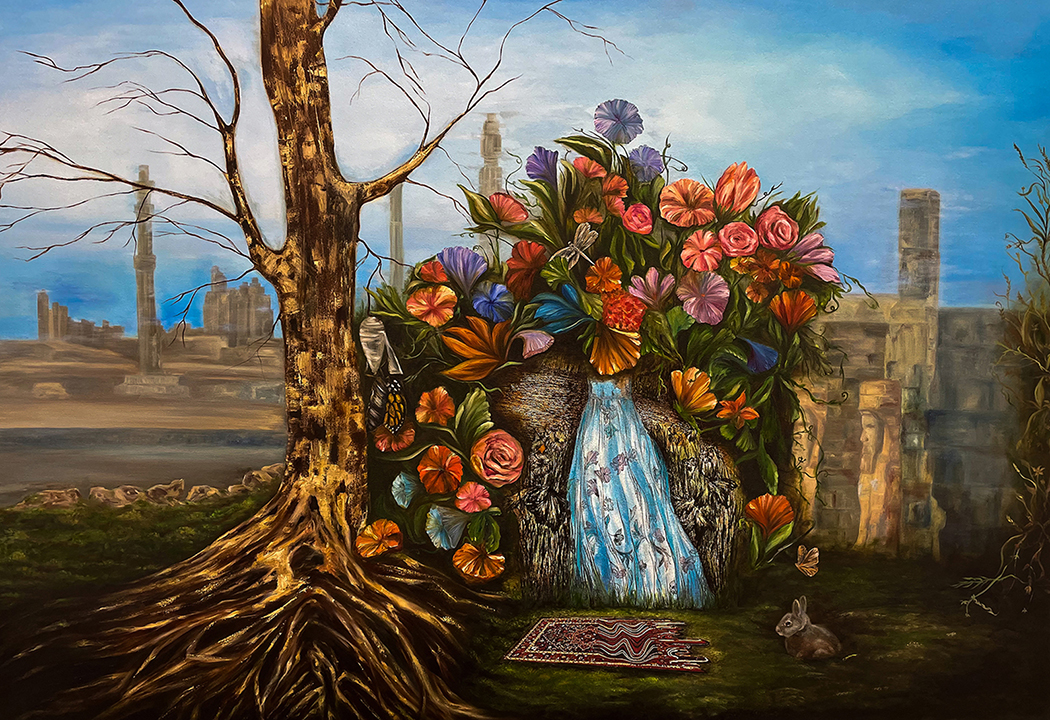 Leila Zolfalipour | Whispers of Resilience
Leila Zolfalipour | Whispers of Resilience
How does your experience as an Iranian-Canadian artist influence the themes and techniques in your work?
My experience as an Iranian-Canadian artist profoundly influences both the themes and techniques in my work. Growing up in Iran, I was deeply immersed in a rich cultural heritage filled with intricate symbols, motifs, and traditional craftsmanship. Persian carpets, historical monuments, and cultural narratives have always been integral to my artistic vision. These elements provide a meaningful foundation for exploring themes of heritage and identity.
As an artist living in Canada, I’ve had the opportunity to engage in a diverse and multicultural environment. This exposure has broadened my perspective and allowed me to blend my Iranian roots with new experiences and ideas. The fusion of these influences enriches my work, enabling me to explore universal themes of femininity, resilience, and our connection to the natural world through a unique lens.
In terms of techniques, my background informs my use of traditional craftsmanship alongside modern digital tools. For instance, integrating Persian motifs into contemporary forms like virtual reality and 3D modelling creates a dialogue between historical and current practices. This approach allows me to bridge cultural contexts and offer viewers an immersive experience that reflects both my heritage and my experiences as a Canadian artist.
Ultimately, my dual cultural experience allows me to create work that is both deeply personal and universally resonant, capturing the complexity of identity and the richness of cross-cultural dialogue.
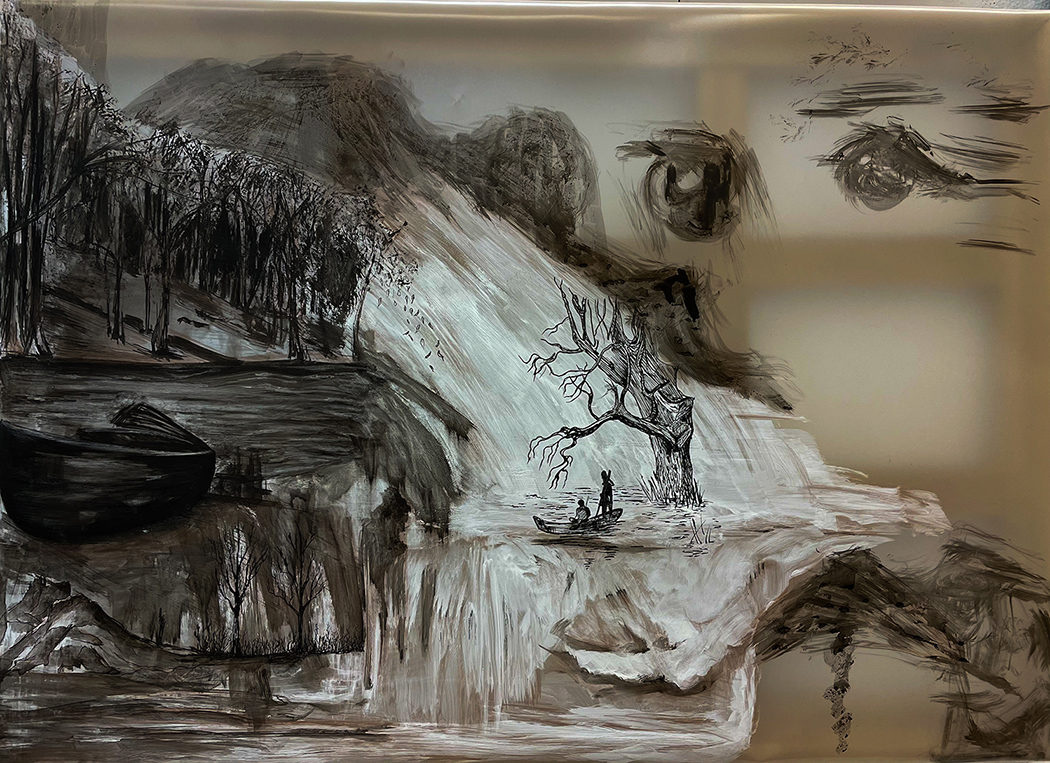 Leila Zolfalipour | Speak Life
Leila Zolfalipour | Speak Life
Your multimedia installation, “Carved Kinship,” includes a Virtual Reality game. What role does this gameplay in the overall narrative of the installation, and how do you hope viewers interact with it?
In Carved Kinship, the Virtual Reality (VR) game plays a crucial role in expanding the narrative and immersing viewers in the thematic exploration of femininity, heritage, and our connection to the natural world. The VR component serves as a bridge between the physical and digital realms, allowing viewers to step into and interact with the world I’ve created beyond the confines of traditional media.
The game is designed to enhance the viewer’s engagement by offering an interactive and immersive experience. It invites users to explore a virtual environment that reflects and extends the themes of the physical sculptures and paintings. By navigating this space, viewers can experience the motifs and symbols from my Iranian heritage in a new, dynamic context, fostering a deeper connection to the artwork.
I hope viewers interact with the VR game by actively exploring the environment, engaging with the 3D-scanned sculptures, and experiencing the soundscape that complements the visual elements. The inclusion of elements like the Persian carpets and the house inspired by my grandmother’s home is intended to evoke a sense of nostalgia and personal reflection. By interacting with these elements, viewers can gain insights into the underlying themes and connect with the narrative on a more personal level.
Overall, my goal is for the VR game to enhance the storytelling of Carved Kinship, offering a multi-sensory experience that deepens viewers’ understanding of the themes and fosters a more immersive and engaging encounter with the art.
“Carved Kinship” is described as a two-year exploration. Could you describe the evolution of this project from its inception to completion? What were some key turning points?
The evolution of Carved Kinship has been a transformative journey, reflecting a deepening exploration of themes related to femininity, heritage, and our connection to the natural world. The project spans two years, during which it has evolved significantly from initial concepts to its final form.
Inception: The project began with a conceptual exploration of how traditional craftsmanship could intersect with modern digital technology. I was inspired by my Iranian heritage and a desire to integrate Persian motifs into contemporary art practices. The initial phase involved sketching out ideas and experimenting with various mediums to determine how best to merge physical and digital elements.
Development: The first major turning point was the decision to incorporate Virtual Reality. This choice allowed me to expand the scope of my work and provide viewers with an immersive experience that complements the physical sculptures and paintings. Developing the VR component involved learning new technologies and tools, such as Unity and 3D modelling software, which was both challenging and exciting.
Creation of Physical Artworks: Another key milestone was the creation of the physical sculptures and paintings. These works were informed by my research into Persian cultural symbols and abstract calligraphy. The process of carving and assembling the wooden sculptures, as well as integrating laser-engraved plexiglass elements, required meticulous craftsmanship and attention to detail.
Integration with VR: Integrating the physical art with the VR game was a significant turning point. This phase involved creating 3D models of the sculptures, designing the virtual environment, and ensuring that the VR experience aligned with the thematic elements of the installation. The inclusion of the VR game allowed viewers to interact with the artwork in new and meaningful ways, bridging the gap between the physical and digital realms.
Final Presentation: The project culminated in its installation at the FAB Gallery at the University of Alberta. This final stage involved setting up the physical artwork, preparing the VR experience, and creating supplementary materials like the zine to make the VR game accessible to all viewers.
Throughout this journey, Carved Kinship has evolved from a conceptual idea into a complex multimedia installation. Each stage has contributed to a deeper understanding of how traditional and digital art forms can intersect and enrich one another, resulting in a compelling and immersive exploration of the themes central to the project.
Your art has been exhibited in both Iran and Canada. How has the reception of your work differed between these two cultural contexts?
Exhibiting my art in both Iran and Canada has provided valuable insights into how cultural contexts influence the reception of my work.
The reception has been closely tied to my cultural heritage. Iranian audiences often connect with the traditional motifs and symbols embedded in my art, appreciating how these elements are integrated into contemporary forms. The response tends to reflect a deep resonance with familiar cultural narratives and historical references, valuing the preservation and reinterpretation of these traditions through modern practices.
Given Canada’s multicultural landscape, the reception of my work has been diverse and varied. Audiences are intrigued by the fusion of traditional craftsmanship with innovative technologies like virtual reality and 3D modelling. There is a strong interest in how these elements come together to explore themes of femininity, heritage, and our connection to the natural world. The emphasis here is often on the experimental and interdisciplinary aspects of my practice, which challenge conventional boundaries and contribute to a rich dialogue within the multicultural context.
Overall, the varying responses in these two contexts highlight how art can engage with different cultural perspectives. In Iran, there is a focus on cultural continuity and tradition, while in Canada, the emphasis is on innovation and cross-disciplinary exploration within a multicultural framework. Both experiences have deepened my understanding of how art communicates across diverse cultural landscapes and have influenced my approach to blending tradition with modernity.
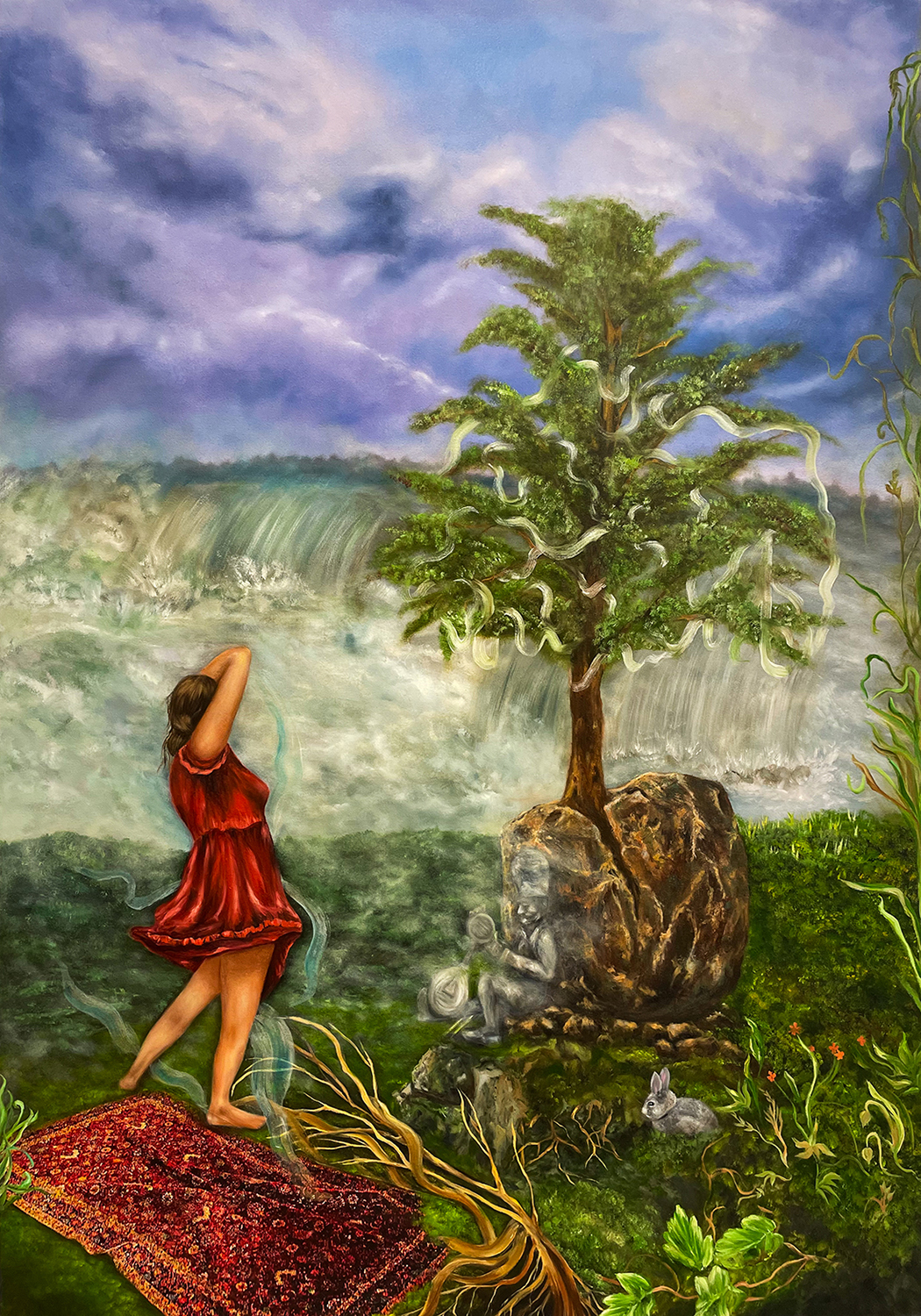 Leila Zolfalipour | Dance to the Life Song
Leila Zolfalipour | Dance to the Life Song
What are some of the most memorable responses or feedback you have received from viewers of your work?
Some of the most memorable responses I’ve received from viewers have been deeply meaningful and varied. Many have shared how the Persian motifs and traditional elements in my art resonate with their personal experiences and cultural connections, evoking a sense of nostalgia and reflection. This feedback underscores the emotional impact of integrating cultural heritage into contemporary practices.
Additionally, viewers have expressed a strong desire to explore the paintings further, often marvelling at how the VR experience allows them to step into and interact with the world created in the artwork. The opportunity to engage with the paintings in a new, immersive way has been particularly appreciated, enhancing their connection to the themes of femininity and nature.
Overall, the diverse and heartfelt responses from viewers highlight the value of blending traditional and modern elements in my work. Their enthusiasm for both the paintings and the VR component enriches my understanding of how my art resonates with different audiences and inspires future projects.
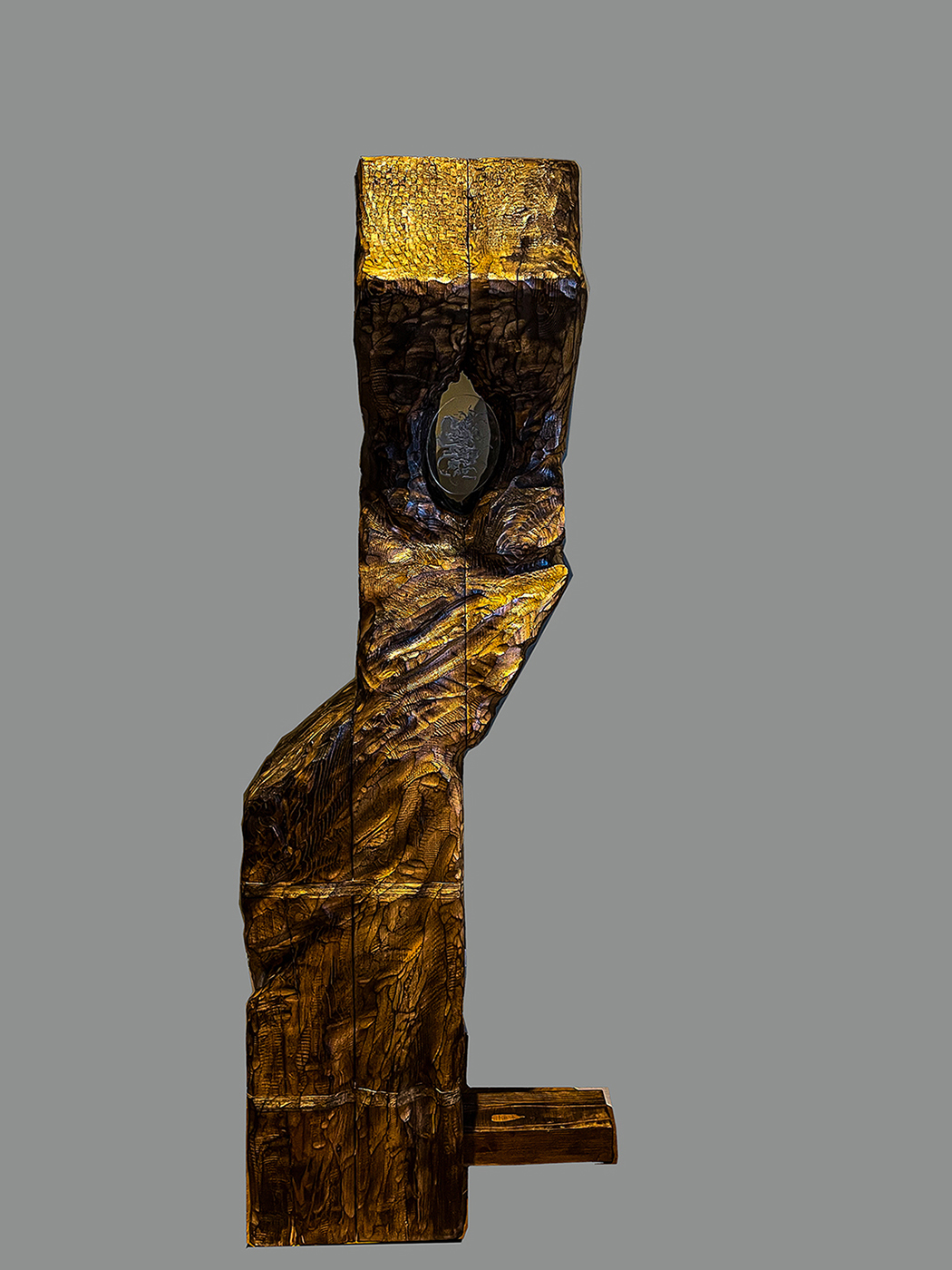 Leila Zolfalipour | Carved Kinship Nurture
Leila Zolfalipour | Carved Kinship Nurture
What advice would you give to emerging artists who wish to blend traditional and digital art forms into their practice?
Blending traditional and digital art forms can create powerful and innovative works, but it requires thoughtful integration and experimentation. Here are some pieces of advice for emerging artists looking to explore this intersection:
● Start with a Strong Foundation: Develop a solid grounding in traditional techniques and media. Understanding the nuances of traditional art forms will provide a strong base upon which to build your digital experiments.
● Embrace Experimentation: Don’t be afraid to experiment with how traditional and digital elements can complement each other. Explore different ways to integrate digital tools, such as virtual reality or 3D modelling, with your traditional practice. Allow yourself the freedom to fail and learn from the process.
● Understand the Strengths of Each Medium: Recognize what each medium brings to your work. Traditional techniques offer texture, depth, and cultural richness, while digital tools provide interactivity, flexibility, and new possibilities for visual exploration. Use these strengths to create a cohesive and dynamic artistic vision.
● Stay Open to Learning: Continuously educate yourself about new technologies and techniques. Attend workshops, take courses, and engage with communities that focus on both traditional and digital art. This will help you stay current and inspired.
● Maintain Your Artistic Voice: While integrating different mediums, ensure that your unique artistic voice remains at the forefront. The fusion of traditional and digital should enhance and express your personal vision, not overshadow it.
● Seek Feedback and Collaborate: Share your work with others and seek feedback from both traditional and digital art communities. Collaboration with artists from diverse backgrounds can also open up new perspectives and ideas.

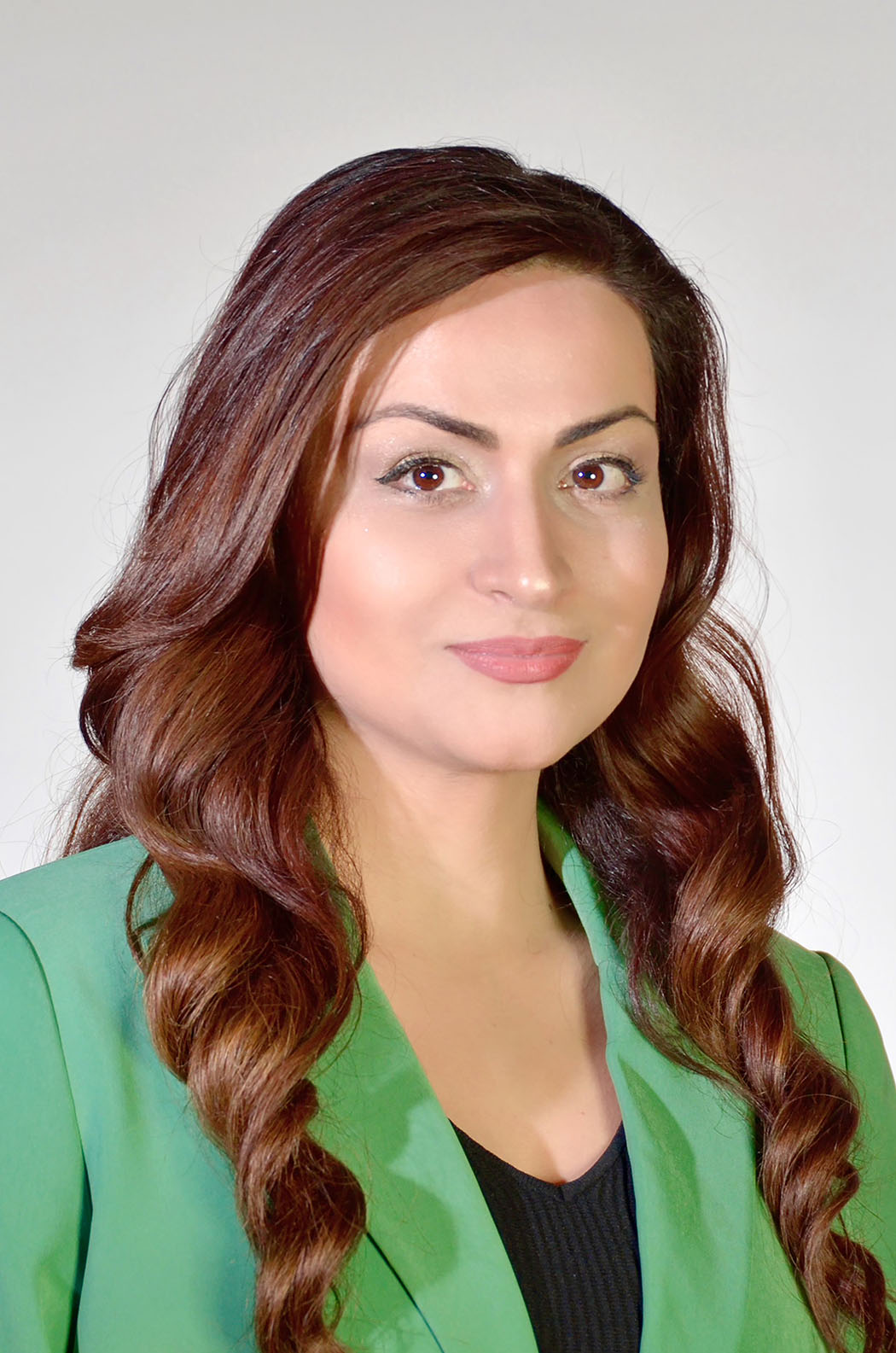
Leave a Reply